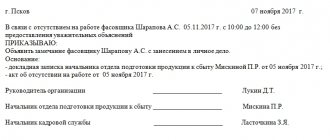The term discipline exists to strengthen the employee’s responsibility for his actions. This is the last measure in relation to those employees who constantly violate the internal regulations of the enterprise or organization.
To begin with, a cautionary note is made, if it does not have an effect, then the management will take strict action. The amount of wages depends on the punishment.
Sometimes this has a positive impact on the employee. Conscientious work makes it possible to submit a petition to the manager to lift the penalty. The imposition of such a punishment can be canceled, so this is one of the positive aspects of such a measure.
Application of disciplinary measures
Penalties are not recorded in the work book. There is a special form T-2, upon registration of which the order number is indicated. In any case, regardless of the violation, when applying for penalties, it is necessary to ensure compliance with the Labor Code. An employee should not be subject to more than one penalty. The violator must be aware of the rules of internal discipline, and his personal signature must be on the relevant document. The time period between the order and the offense should not be more than six months.
The punishment order is prohibited from being applied during the period:
- public service employees;
- vacation and sick leave periods.
The employee must personally familiarize himself with the order and draw up an explanatory note. The recovery must comply with the deadlines specified in the Labor Code; its extension is also possible, but only in accordance with the law.
An employee who has been subject to a penalty has the right to challenge it if it was applied in violation of the provisions of the law. And as a rule, such labor disputes are resolved in favor of the employee and his guilt will be unproven.
Procedure for issuing disciplinary sanctions
The rule for disciplinary action is simple: one offense results in one penalty.
First of all, the employer documents the fact of the violation: issues an order to conduct an internal inspection, receives a conclusion and an internal inspection report or a memo addressed to the manager. Such a document should indicate what the employee did and when, what point of the company rules he violated, and what consequences occurred. The company is obliged to prove the fact of a disciplinary offense and undesirable consequences for the company.
The company also requests a written explanation from the employee about the reasons and circumstances of the misconduct. It is better to document this company request. If the employee is deprived of the right to an explanation, the disciplinary sanction may be considered illegal.
Next, the employee has two days to provide a written explanation. If the employer considers the reasons for the misconduct to be valid, he may not impose a penalty. If the employee does not provide an explanation, the company draws up a statement of refusal to provide an explanation.
After this, the company issues a collection order, and the employee signs it within three working days. If the employer refuses to sign the order, he draws up a report. There is no unified form for such an order, but the document must contain the employee’s full name, position and department, the offense committed and the violated points of the company’s rules, references to accompanying notes, conclusions of an internal audit, explanatory note, etc., as well as the type of penalty itself.
An entry about the penalty is not made in the work book, unless it is a matter of dismissal. A record of collection is also usually not entered into a personal card in Form T-2, but if necessary, this can be done in the “Additional Information” section.
An employee can appeal the penalty in court and the labor inspectorate.
Duration of disciplinary action
The collection can be considered invalid if 1 year has passed since the time the order was accepted. If an unscrupulous employee is punished again before the end of this period, the validity period of the first order is reset and a new period is established from the date on which the new order was approved. This allows you to record two punishments at once. This may lead to the emergence of grounds to record the fact of repeated violations. The manager has the right, according to the Labor Code, to dismiss the employee. For the latter, the penalty will not directly affect the future career.
Transferring to another position at the enterprise does not affect the duration of the measures or the termination of the order. Removal of penalties is carried out by decision of the manager or upon termination of the employment relationship, since such orders are distributed only within the organization.
How to place an order
The order can be written on a clean, empty A4 sheet or company letterhead, either by hand or in printed form (this does not matter, but the computer significantly speeds things up). In any case, the document must contain the original signature of the head of the company, as well as the autograph of the employee for whom the order was drawn up (thus the employee certifies that he has read the document). The order can be certified by a seal, but since 2016, the presence of a stamp or seal for legal entities is not a legal requirement.
Once the order is issued, the employee is deemed not to have been subject to discipline. All previously taken measures and restrictions in force in relation to it are cancelled.
The order is drawn up in a single copy and, after its acceptance, as a guide to action, it is sent for storage to the company’s archive, which contains the time established for such documents.
Cancellation after expiration
The employer can cancel the order ahead of schedule; for this, a new order is also issued. If the validity period has expired, it will be canceled automatically without issuing a special document. The employee also does not have to be notified. But the employee must take this situation seriously and strictly observe internal discipline during the term and avoid repeated violations.
The employee may be on vacation or absent from the workplace for other reasons; his presence at the workplace is not necessary for automatic removal of the penalty. But this only applies to reprimands and remarks. If we are talking about dismissal, cancellation does not apply to this type of penalty.
A penalty that has expired cannot be a basis for denying an employee incentives, i.e., it should not have any consequences. This also applies to wages, which take into account bonuses and other material rewards. Interrupted working hours are also taken into account for the possibility of obtaining titles.
Remarks can be automatically removed when the employee, from the moment of signing the order of collection, no longer violates the internal labor discipline of the enterprise.
Disciplinary liability of administrative civil servants Printable version
The basis for imposing a disciplinary sanction is the commission of a disciplinary offense by an administrative civil servant.
For committing a disciplinary offense by an authorized person, disciplinary penalties provided for by law may be imposed on an administrative civil servant.
The disciplinary sanction must correspond to the severity of the disciplinary offense committed and the degree of guilt of the person who committed it.
When determining the type of disciplinary sanction, the following are taken into account in total:
1) the content and nature of the offense;
2) the circumstances under which the offense was committed (time, place, method and other circumstances of its commission), the guilt of the administrative civil servant;
3) the negative consequences that the offense committed or could entail;
4) the previous behavior of the person who committed it;
5) work experience in the relevant field of activity;
6) other circumstances characterizing the personality of the administrative civil servant.
There are the following types of disciplinary action:
- comment;
- rebuke;
- severe reprimand;
- warning about incomplete professional compliance;
- demotion;
- dismissal from position
The procedure for imposing disciplinary sanctions
The authorized person makes the following decisions:
1) impose an appropriate disciplinary sanction;
2) sends materials for additional official investigation within the time limits for imposing a penalty:
3) does not impose a disciplinary sanction.
The materials of the additional internal investigation are considered by the Commission in a different composition.
The person subject to the penalty is notified of the imposed disciplinary sanction by the personnel management service (personnel service) of the relevant government body within three working days from the date of issuance of the act on the imposition of the penalty against signature. If the person subject to the penalty refuses to confirm familiarization with his signature, a corresponding entry is made about this in the act of imposition of the penalty or a report is drawn up.
If it is impossible to familiarize the person subject to the penalty with the act of imposing a penalty, the personnel management service (personnel service) sends him a copy of the act by letter of notification.
The imposed disciplinary sanction may be announced to an administrative civil servant at a meeting of the relevant state body, its board or in the presence of employees determined by the authorized person who imposed this sanction.
If, as a result of an internal investigation, it is concluded that an administrative civil servant committed actions that have possible signs of a criminal offense or an administrative offense, the authorized person immediately transfers the received materials to law enforcement or other authorities.
In cases where a law enforcement agency terminates criminal proceedings against a civil servant, but if there are signs of a disciplinary offense in his actions, the materials on the case are sent to the authorized body.
Disciplinary sanctions are imposed by issuing orders or instructions from an authorized person.
The act of imposing a disciplinary sanction shall indicate the person on whom the sanction is imposed, the offense for which the sanction is imposed, and the type of sanction.
The act of imposing a disciplinary sanction by the personnel management service (personnel service) is sent for review to the immediate head of the structural unit of the administrative employee subject to disciplinary liability, and to the management of the state body.
Information and acts on disciplinary sanctions that have not been lifted are subject to recording by the personnel management service (personnel service) of the state body by entering it into the employee’s service record.
Information on disciplinary sanctions imposed by an authorized person on employees who committed disciplinary offenses that discredit the public service is subject to mandatory submission by the personnel management service (personnel service) to the authorized body for legal statistics and special records.
Guarantees of the rights of administrative civil servants when bringing them to disciplinary liability
An administrative civil servant brought to disciplinary liability for committing an offense may have his own representative.
It is prohibited to submit complaints for consideration to an authorized person whose actions are being appealed.
Appealing a decision to impose a disciplinary sanction does not suspend its execution.
Grounds for cancellation of penalties
An employee has the right to early cancellation of a collection order under the following circumstances:
- conscientious work during the period of validity of the order;
- fulfillment of the established work plan beyond the norm;
- participation in the life of the team;
- identification and prevention of accidents and other violations;
- introducing rationalization proposals and new techniques.
If the employee has corrected himself, the following may intercede on his behalf: the head of the enterprise or organization, the employee himself, the head of the local trade union, a guarantor from the team, the boss of the punished employee himself. The initiator of the appeal must receive a link so that he can arrange a newsletter for recipients (Article 194 of the Labor Code of the Russian Federation). The employee must read the order to lift the penalty and sign.
How to draw up an order to remove a disciplinary sanction
There is no unified, obligatory template for the removal of a disciplinary sanction, so companies can go two ways to formalize it: either draw it up in free form, or use a template developed within the enterprise (however, in this case it must be approved in the accounting policy firms). The order has a completely standard and understandable structure, which should include a number of necessary information:
- Name of the organization,
- personal data about the employee,
- date of compilation,
- information about previous penalties
- and the meaning of this order,
- as well as the persons responsible for its implementation.
Removal of foreclosure
When the penalty is canceled by the director, he must issue the order himself. If the request comes from other persons, then a petition is submitted to the manager. This document must indicate the persons who have read the order, namely: the violator himself, the initiator of the petition, and an employee of the personnel department.
The canceled punishment must be entered on the T-2 card, the order number and the date of its entry into force. If the work schedule is violated a second time after the order is drawn up and signed, the cancellation will not be extended. It will not serve as a basis for repeated misconduct by the employee.
Who is writing the document?
Any order is always issued on behalf of the head of the organization, but it can be drafted
- HR specialist,
- lawyer
- or company secretary.
Regardless of whose competence it is to write this document at a particular enterprise, it must be a person who has the necessary level of knowledge and education, knows the rules for drawing up this kind of internal orders, and is also familiar with the legislation of the Russian Federation in the field of labor and civil legislation.
Petition for removal of foreclosure
It is issued in the name of the manager. The document must contain the reasons for the disciplinary sanction, the facts for early termination of the order, and the full name of the punished employee. At the end of the petition the number of the order and the date of its entry into force are indicated.
The document must be signed by the immediate supervisor of the violator, the chairman of the trade union. The protocol (its number) must be attached to it. Representatives of the team who were present at the meeting also sign.
Types of disciplinary punishments
Based on the extent of the violation, the employee may be subject to different types of disciplinary action.
For example, being late for work may result in a written reprimand, but absenteeism twice without explanation can lead to dismissal. Punishment is also imposed for disclosure of confidential information and trade secrets, immoral behavior, violation of labor protection and safety rules, abuse of authority, etc.
Any types of disciplinary punishment (except, for obvious reasons, dismissal) can be canceled ahead of schedule. They are automatically withdrawn after a year.
Automatic cancellation
The expiration of the punitive measure means its automatic liquidation, which does not require official registration - the issuance of an order, as well as notification to the employee. For its occurrence, strict compliance with internal regulations throughout the entire period is necessary and, as a result, the absence of repeated penalties (clause 1 of Article 194 of the Labor Code of the Russian Federation).
According to labor law, the employee may be subject to disciplinary action. Find out what the deadline is for applying disciplinary action.
Automatic withdrawal does not depend on the employee being at work or on vacation. This applies only to the first two types of disciplinary action: reprimands and reprimands; dismissal cannot be annulled.
A lifted penalty does not leave any consequences. Namely, it cannot be taken into account when an employee commits a new violation, which will be considered the first. At the same time, the use of incentive measures is resumed. For example, when calculating wages, bonuses and rewards begin to be taken into account again, or the interrupted countdown of time required to assign the next rank continues.
Automatic removal of a remark/reprimand for violation of labor discipline occurs if the employee does not repeatedly violate the set of internal rules of the enterprise within a year from the date of the issuance of the order of punishment.
Appeal
As Art. 193 of the Labor Code of the Russian Federation, an employee who does not agree with the manager’s decision has the right to appeal it to:
- Labor Dispute Commission established at the enterprise. Its composition includes officials and employees in equal proportions.
- State Labor Inspectorate.
- Court.
A copy of the application with a note of acceptance remains with the employee. It is better if he provides convincing arguments in favor of his point of view, supported by specific articles of the Labor Code of the Russian Federation. However, it is the responsibility of the employer to justify the punishment imposed. At least a month is allotted for the investigation of the case, during which the punishment is suspended. As a result, two options are possible:
- Refusal to satisfy the complaint due to the absence of violations of the Labor Code.
- An order to the company to cancel the collection.









